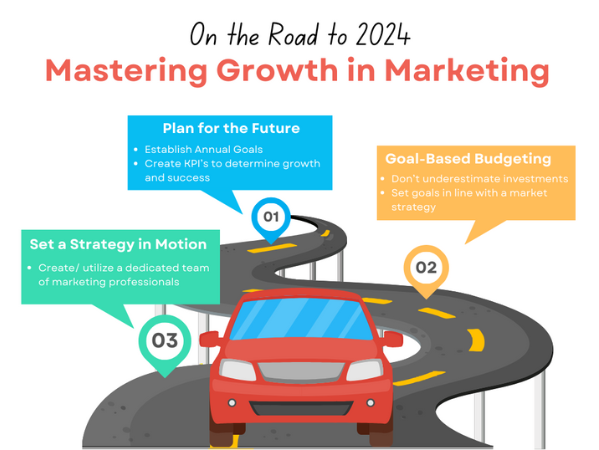If you’re like us, you might have blinked and realized that this year is coming to an end! With the new year approaching rapidly, it’s time to start planning for 2024. What kind of growth do you envision for your business? How can you attain these goals? Where should you begin?
As long-time marketing strategists, we understand the stress that comes from planning for the future – especially with the persistent ticking of the clock in your mind. Navigating the complex terrain of marketing budgeting and strategy can be a daunting task, often accompanied by the relentless pressure of making the right choices promptly. This article aims to equip you with a guide for creating an effective marketing budget and strategy that empowers your business to survive and thrive in today’s ever-evolving market landscape.
Planning for the Future, Understanding Market Conditions
Establishing annual SMART goals and objectives for your business forms the foundation for crafting an effective marketing strategy. But understanding the ever-changing landscape of the industries you serve will allow you to develop a marketing plan and budget that allows for sustainability and flexibility – remember that we must always be ready and able to pivot when necessary. A few questions to ask yourself to get started:
- What trends are we seeing in the industries we serve – market conditions, competitor analysis, geographic focus, etc.?
- What are our growth goals and objectives – company and product specific, short and long term, geographically? (TIP: Get very granular with this one! Ultimately, the overall goal of any company is to increase revenue and net profit … knowing your financial status and understanding the industry climate will help you to assign growth percentages that are attainable.)
- Where do I see the growth coming from – new products and services, M&A opportunities, diversified markets, general new business development, etc.?
Now it’s time to break down your due diligence into digestible pieces using key performance indicators (KPIs).
KPIs are brand-specific objectives used to steer your business toward your goals. Think of your annual goal as a cross-country road trip – KPIs are the pit stops and scenic views you visit along the way. Once your road trip is planned, you can begin your journey to your first pit stop. Your experience with your first KPI should dictate the next goal that you set.
Here are a few examples of marketing KPIs:
- Big picture KPIs:
- Launch X products/services in 2024.
- Overtake competitor X in market share by Q2.
- Increase company EBITDA by X percent by Q3.
- Identify X M&A opportunity(s) in 2024. - Marketing initiative KPIs:
- Increase organic website traffic by X percent in Q1 (TIP: Selecting a challenging but achievable goal is best).
- Obtain X executive interviews in X publications by Q3.
- Boost brand awareness by gaining X social media followers per month.
- Attend X industry events, capturing a minimum of X post-event new business meetings per event.
With your annual SMART goals and KPIs identified, it’s time to shape and mold your marketing budget.
Goal-based Budgeting
The number one mistake businesses make while planning their annual marketing budgets is underestimating their investments. If your goal is to grow your business by X amount, but your marketing budget only covers a bulk order of branded pens – you will be disappointed. The old adage, “you have to spend money to make money,” is true ... but if you spend and invest properly, you do not have to break the bank to see results.
Overcompensating your marketing budget will lead to a negative return on investment (ROI). This LinkedIn article showcases a simple strategy to help develop a targeted and maintainable marketing budget to fit with your growth goals:

Goal 1: Maintain market position.
- Allocate 1-2% of your top-line revenue to engage and retain current customers with simple strategies.
Goal 2: Increase market share with moderate growth.
- Allocate 3-4% of your top-line revenue to attract new prospects and retain current customers with advanced strategies and tools.
Goal 3: Ambitious growth.
- Allocate 5% or more of your top-line revenue to accelerate results with complex strategies and tools.
Marketing spend across industries can look vastly different. In this HubSpot article, check out the percentage of revenue used in marketing budgets for various industries, according to survey results. If you are looking for benchmarks for budgeting, take a look. Of special interest on the list are: energy, manufacturing, mining and construction, technology and transportation. >> Check out this article noting marketing spend by industry.
Set Your Strategy in Motion
Now that you have outlined your goals and developed an investment plan, it’s time to implement your marketing strategy! To ensure the successful realization of your business goals, it’s crucial to surround yourself with a team of dedicated marketing professionals.
If you require assistance in developing and executing a marketing budget and strategy for your business, get in touch with Foster Marketing today! With nearly 44 years of experience, our strategic thinkers are here to help you through your New Year’s transition and beyond!
Connect with us to discuss your plans for 2024.
